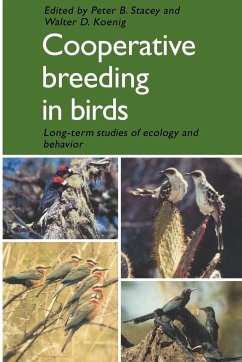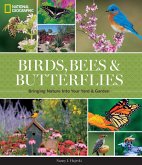Cooperative breeding is an unusual kind of social behaviour, found in a few hundred species worldwide, in which individuals other than the parents help raise young. Understanding the apparently altruistic behaviour of helpers has provided numerous challenges to evolutionary biologists. This book includes detailed first-hand summaries of many of the major empirical studies of cooperatively breeding birds. It provides comparative information on the demography, social behaviour and behavioural ecology of these unusual species and explores the diversity of ideas and the controversies which have developed in this field. The studies are all long-term and consequently the book summarises some of the most extensive studies of the behaviour of marked individuals ever undertaken. Graduate students and research workers in ornithology, sociobiology, behavioural ecology and evolutionary biology will find much of value in this book.
Table of contents:
Introduction P. B. Stacey and W. D. Koenig; 1. Splendid Fairy-wrens: demonstrating the importance of longevity I. Rowley and E. Russell; 2. Green Woodhoopoes: life history traits and sociality J. D. Ligon and S. H. Ligon; 3. Red-cockaded Woodpeckers: a 'primitive' cooperative breeder J. R. Walters; 4. Arabian Babblers: the quest of social status in a cooperative breeder A. Zahavi; 5. Hoatzins: cooperative breeding in a folivorous neotropical bird S. D. Strahl and A. Schmitz; 6. Campylorhynchus wrens: the ecology of delayed dispersal and cooperation in the Venezuelan savannah K. N. Rabenold; 7. Pinyon Jays: making the best of a bad situation by helping J. M. Marzluff and R. P. Balda; 8. Florida Scrub Jays: a synopsis after 18 years of study G. E. Woolfenden and J. W. Fitzpatrick; 9. Mexican Jays: uncooperative breeding J. L. Brown and E. R. Brown; 10. Galapagos Mockingbirds: territorial cooperative breeding in a climatically variable environment R. L. Curry and P. R. Grant; 11. Groove-billed Anis: joint nesting in a tropical cuckoo R. R. Koford, B. S. Bowen and S. L. Vehrencamp; 12. Galapagos and Harris' Hawks: divergent causes of sociality in two raptors J. Faaborg and J. C. Bednarz; 13. Pukekos: different approaches and some different answers J. L. Craig and I. G. Jamieson; 14. Acorn Woodpeckers: group-living and food storage under contrasting ecological conditions W. D. Koenig and P. B. Stacey; 15. Dunnocks: cooperation and conflict among males and females in a variable mating system N. B. Davies; 16. White-fronted Bee-eaters: helping in a colonially nesting species S. T. Emlen; 17. Pied Kingfishers: ecological causes and reproductive consequences H.-U. Reyer; 18. Noisy Miners: variations on the theme of communality D. D. Dow and M. J. Whitmore; Summary J. N. M. Smith; Index.
Cooperative breeding is an unusual kind of social behaviour, found in only a few hundred species, in which individuals other than the parents help to rear the young. This book includes details of many of the major empirical studies of cooperative breeding birds and explores the diversity of ideas and controversies which have developed in this field.
Hinweis: Dieser Artikel kann nur an eine deutsche Lieferadresse ausgeliefert werden.
Table of contents:
Introduction P. B. Stacey and W. D. Koenig; 1. Splendid Fairy-wrens: demonstrating the importance of longevity I. Rowley and E. Russell; 2. Green Woodhoopoes: life history traits and sociality J. D. Ligon and S. H. Ligon; 3. Red-cockaded Woodpeckers: a 'primitive' cooperative breeder J. R. Walters; 4. Arabian Babblers: the quest of social status in a cooperative breeder A. Zahavi; 5. Hoatzins: cooperative breeding in a folivorous neotropical bird S. D. Strahl and A. Schmitz; 6. Campylorhynchus wrens: the ecology of delayed dispersal and cooperation in the Venezuelan savannah K. N. Rabenold; 7. Pinyon Jays: making the best of a bad situation by helping J. M. Marzluff and R. P. Balda; 8. Florida Scrub Jays: a synopsis after 18 years of study G. E. Woolfenden and J. W. Fitzpatrick; 9. Mexican Jays: uncooperative breeding J. L. Brown and E. R. Brown; 10. Galapagos Mockingbirds: territorial cooperative breeding in a climatically variable environment R. L. Curry and P. R. Grant; 11. Groove-billed Anis: joint nesting in a tropical cuckoo R. R. Koford, B. S. Bowen and S. L. Vehrencamp; 12. Galapagos and Harris' Hawks: divergent causes of sociality in two raptors J. Faaborg and J. C. Bednarz; 13. Pukekos: different approaches and some different answers J. L. Craig and I. G. Jamieson; 14. Acorn Woodpeckers: group-living and food storage under contrasting ecological conditions W. D. Koenig and P. B. Stacey; 15. Dunnocks: cooperation and conflict among males and females in a variable mating system N. B. Davies; 16. White-fronted Bee-eaters: helping in a colonially nesting species S. T. Emlen; 17. Pied Kingfishers: ecological causes and reproductive consequences H.-U. Reyer; 18. Noisy Miners: variations on the theme of communality D. D. Dow and M. J. Whitmore; Summary J. N. M. Smith; Index.
Cooperative breeding is an unusual kind of social behaviour, found in only a few hundred species, in which individuals other than the parents help to rear the young. This book includes details of many of the major empirical studies of cooperative breeding birds and explores the diversity of ideas and controversies which have developed in this field.
Hinweis: Dieser Artikel kann nur an eine deutsche Lieferadresse ausgeliefert werden.








